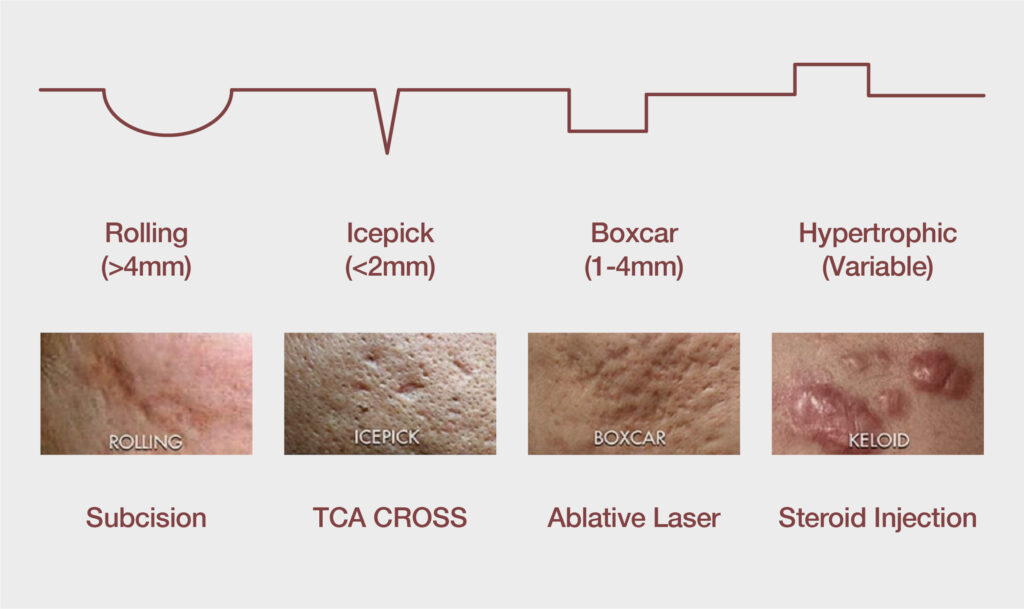
Scars In Our Lives
Scars are the silent storytellers of our bodies, marking our history with each imperfection. From the most minor scratches to major surgical procedures, scarring is an inevitable part of the human experience. Explore the science behind scarring, its common occurrences, and what can be done to treat and minimize their appearance.

How Do Scars Form?
Scarring is the body’s natural response to injury, a way to repair and protect damaged tissue. When the skin or other tissue is wounded, the body rapidly starts a complex tissue regeneration process. This process is divided into four main stages: hemostasis, inflammation, proliferation, and remodeling. Scars form during the last phase, remodeling, where collagen fibers are laid down to repair the tissue. When the collagen fibers are laid down in a different fashion from uninjured skin, a scar then develops.
| Rolling Scars | – Wide Depressed Scars | – Requires Subcision |
| Ice Pick Scars | – Deep Narrow Scars | – Requires TCA CROSS |
| Boxcar Scars | – Shallow Scars | – Requires Time Freeze |
| Keloid Scars | – Overgrowth of Scars | – Requires Steroid Injection |

Where Does Scarring Commonly Occur?
Scarring can happen anywhere on the body, but certain areas are more prone to scarring due to the nature of the tissue and the potential for repeated injury. Common areas for scarring include:
- Face: Acne scars, surgical scars, and trauma-induced scars.
- Chest: Often the location for cardiac surgery scars.
- Abdomen: Common for post-C-section or general surgical scars.
- Joints: Secondary to falls and injury.

Can You Explain The Different Types Of Scars?
Scars vary in appearance and severity. Common types include:
Types of Scars
- Hypertrophic Scars: Raised and red initially, these scars form at the site of an injury. They usually regress and lighten over time but may remain raised.
- Atrophic Scars: These are depressed scars, like the pits and dents left by acne or chickenpox. They can be referred to boxcar, rolling or ice pick scars.
- Keloid Scars: Thick, raised, and more extends beyond the original injury. They can be itchy and painful. Keloids can grow bigger over time.
- Contracture Scars: These scars can limit movement due to tightening skin and underlying tissue. Common after burns.
- Cellulite Scars: Cellulite can be considered a type of scarring, and it causes dimples in the skin surface. It is common to notice these on buttocks or thighs after pregnancy or weight changes. They can be treated similar like scars.
- Stretch Marks: Striae, or stretch marks, form when the skin is stretched beyond its limits such as after pregnancy.

What Are The Available Aesthetic Treatments For Scars?
Scar treatment options vary depending on the nature and severity of the scar:
- Topical Treatments: Over-the-counter creams and ointments can help reduce the appearance of scars. Silicone-based gels and sheets are common options.
- Corticosteroid Injections: Mainly for keloids. These can help reduce inflammation and flatten raised scars.
- Time Freeze Laser Treatment: Various laser treatments can improve the appearance of scars by stimulating collagen production and breaking down scar tissue. The Time Freeze Laser enhances collagen and elastin production and helps in remodeling of the scar and enhances the surrounding skin, giving a improved appearance.
- 4D Scar Reconstruction: 4D Scar Reconstruction employs the use of minimally invasive surgery which breaks down the abnormal scar collagen fibers, commonly seen in atrophic scars. The abnormal scar collagen fibers tethers the overlying skin down, resulting in a depressed region. By breaking these abnormal collagen fibers, it allows the depressed area to be lifted. Dependent on the degree of atrophy, collagen stimulating agents can also be employed to further enhance collagen production in the depressed area, allowing for further improvement to the depressed region.
- 4K Body Lift: 4K Body Lift employs the use of radiofrequency energy and needles to break down the scars. This duo approach in breaking down scars mechanically and via radiofrequency energy can alter the components of a scar, allowing it to improve.
- Collagen Stimulating Agents: Collagen stimulating agents invigorate the skin to produce more collagen and elastin, improving volume to areas of depression, allowing these areas to lift up, evening the skin surface.
- Surgical Revision: Surgical revision may be necessary for extensive or disfiguring scars. This involves removing the scar tissue and re-closing the wound.


